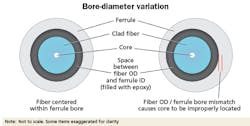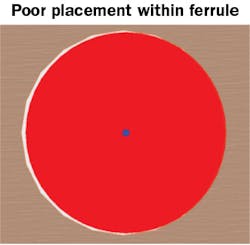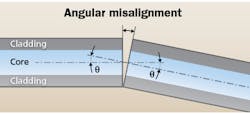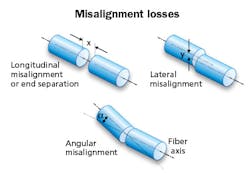The quality of an optical connection often can be directly traced to the ferrule used in constructing the connector.
By Brad Everette, America Ilsintech
Many factors can affect the reliability and performance of a fiber connection. Anything from the quality of the fiber-optic cable you use to the integrity of the connector can adversely affect the overall performance of your connection. Often the quality of the connection can be directly traced to the ferrule used in constructing the connector. Yet when so many connectors are being manufactured overseas to different standards, how can you have confidence in the connectors you are using? The best place to start is at the ferrule—one of the first components needed for superior connections and for high-performingconnectivity.
Connector ferrules can be made from various materials such as plastics, steel or ceramics. A majority of ferrules are typically made from zirconia ceramic, which is durable and manufactures well to strict tolerances for performance standards. Ceramic ferrules are manufactured with a selection of hole or inner (bore) diameters ranging from slightly larger than the optical fiber diameter to slightly smaller. This variance in hole size would allow for minute variations in the manufactured optical fiber cladding diameters. For example, for a 125-µm optical fiber, ferrules are available with hole sizes ranging from 124µm to 127µm.
When a connector is produced, the optical fiber is typically epoxied into the ferrule with the end protruding slightly beyond the endface of the ferrule. The optical fiber end is later trimmed and polished with the ferrule endface for a precise fit. Because the ferrule must align the optical fiber end precisely, several factors can affect the performance of an interconnection, including ferrule bore diameter mismatch, concentricity variations, non-circularity of the ferrule, lateral misalignment, end separation, and angularmisalignment.
Overall, these factors can seem like microscopic variances. However, they have the ability to tremendously affect the performance and reliability of your connection. When your connections are critical, it is imperative that you understand the impact these factors can have on your overall performance.
In this article, we will discuss how important each of these factors is to ferrule manufacturing and how to maximize the performance of your fiberconnectivity.
Variation in bore diameter results in the fiber not being fixed along the center axis. This variation contributes to a core-alignment mismatch, which can increase connection loss.
Bore diameter
Ferrules come with varying bore diameters depending on the size of the optical fiber it will host. One reason for variance would be that, sometimes, the diameter is purposefully slightly larger than normal from a “standard” fiber diameter to allow for differences in cladding. Cladding is defined as a layer of either glass or plastic that surrounds the inner core with a lower index of refraction. Through reflection, it confines light to the core to improve lighttransmission.
Ferrules are manufactured using an injection-molding process of the ceramic. After the initial molding step, the ferrules are put through a precision boring process and then polished to remove any machining marks, nicks or scratches. The ferrules then have the bore diameter measured and sorted into different “grades.” Matching the grade of the ferrule to the application and desired performance level is a key step in preparation, along with specifying a fiber with low variation of the cladding diameter.
Singlemode ferrules require the highest tolerance on bore diameter due to the high tolerances necessary to guarantee correct alignment of the fibers (dictated by the small size of the optical core, typically 9 microns in diameter). A mismatch of even a small amount between two singlemode optical fibers can produce large losses in light transmission. Multimode ferrule terminations can be more forgiving due to larger core size (50 microns, 62.5 microns, or up to 100 microns) that isn’t as sensitive to mismatch.
Bore diameter is the first step in a quality termination. Unwanted variation in bore diameters will allow the optical fiber to not be fixed along the center axis, due to variation in placement. This variation will contribute to a mismatch in core alignment, possibly increasing the connection loss.
A model of a typical singlemode optical fiber, with cladding (in red) over a singlemode core (in blue), inserted into an LC ferrule. As shown here, the optical fiber has poor placement within the ferrule bore, evidenced by the white gap along the edge.
The bore diameter depends on extremely precise and minute factors. Fiber optics is a technology that requires extreme accuracy and attention to detail. If this factor falls short to a tiny degree, loss of light, and therefore data, occurs. The greater the discrepancy, the lower the connectivity performance.
At Ilsintech we manufacture ferrules used to make splice-on connectors and to make connectors for cable assemblies. After creating the ferrules and machining the various features, each ferrule is subjected to multiple measurements to ensure compliance to internal standards. Each ferrule is graded according to dimensional performance (including bore diameter) and identified for where it will be used, or potentially discarded if it does not meet our performance standards
Concentricity
Concentricity is the positioning of one cylindrical item along the axis of another cylindrical item. When lining up two terminated ferrules, the optical fibers must line up in order for light to be transmitted from one to another. Any amount of mismatch (where one core is not concentric to another) will contribute to optical loss.
In fiber optics, there are three important items to consider.
- The concentricity of the inside bore of the ferrule—is the hole centered with respect to the outside of the ferrule?
- The concentricity of the fiber core—is it centered within the fiber cladding?
- The concentricity of the fiber within the ferrule—is the main axis of the cladding along the main axis of the bore opening?
It is critical for a connector manufacturer to use high-quality fiber from reputable sources, with tight tolerances on core concentricity, as we do. We rely on our partners to provide us fiber that meets or exceeds the tolerances we set, and we review the documentation and inspect the fiber when we get it to make sure it meets our needs.
Additionally, we use high-quality, high-tech equipment to make the bore opening in the ferrules and to minimize the amount that the bore opening deviates from the true center of the ferrule. We inspect the ferrules to ensure quality and performance using a V-groove-based microscope system. Each ferrule is placed in the groove of the V-block with the end of the fiber facing the light source. The ferrule is rotated in steps as images are taken. At each step, the center coordinates of the ferrule core are recorded. This creates an average of how concentric the ferrule core is, providing you with an accurate measurement.
Then we inspect each completed assembly after fiber insertion for placement of the fiber within the bore. Ilsintech holds the tolerances to be tight on the fiber and the bore diameter, which minimizes the amount that the fiber can move within the bore. Minimizing the movement will minimize the contribution toward insertion loss.
Cylindricity, the 3-dimensional version of circularity, typically affects the quality of a product and, ultimately, the quality of the transmission between two ferrules.
Circularity
The term circularity refers to how close any given object is to a perfect circle, which would satisfy the requirement that the circumference equals the diameter multiplied by Pi (3.14159). The tolerance, or tolerance zone, refers to an acceptable range of deviation away from perfection.
When referring to a ferrule, you will be measuring cylindricity, as this is the 3-dimensional version of circularity. Cylindricity is the circularity extended along the main axis of the ferrule. Cylindricity is an important factor in many manufacturing processes because it typically affects the quality of a product, and ultimately the quality of the transmission between two ferrules.
In this case, you are specifically measuring the cylindricity of the ferrule itself as well as the bore that goes through the ferrule. Rather than simply measuring the circularity on one plane, you’ll have to record measurements of many locations along the length of the cylinder to obtain an average. The average deviation away from perfection must be within tolerance.
If the cylindricity of the ferrule and the ferrule bore are not within tolerance, then the core of the transmitting ferrules and the optical fibers could be misaligned. A loss of light will occur as the transmit fiber-optic cable transfers data to the receive cable.
Shaft alignment is the process of aligning two or more shafts with each other to within a tolerated margin.
Lateral alignment
Lateral alignment refers to the degree of being parallel for either the ferrules or the fibers. Misalignment occurs when either one of these components are offset from each other rather than lined up. This is different from angular misalignment because it refers to the variation of the components in one direction, while angular misalignment refers to the discrepancy due to rotational error.
A loss in optical power will occur with lateral misalignment. This mismatch prevents some of the light from the transmit optical fiber to enter the cladding of the receive optical fiber. As the lateral misalignment increases, optical power lowers because some of the light is lost during transmission. Lateral misalignment can occur for two reasons.
The first reason would be because the openings of the receive and transmit ferrules are not perfectly matched up. This may be due to poor alignment within the adapter. Adapters are devices used to provide initial alignment of the ferrules and to hold the aligned ferrules in place. This alignment is performed using some sort of a sleeve, typically made of a metal alloy (good alignment properties) or a ceramic (better alignment properties). We recommend the use of high-quality components in your fiber-optic system. The phrase “you get what you pay for” really does apply here.
The second reason misalignment can occur is from lack of concentricity of fiber within the ferrule. Sometimes, the ferrule bore is made to be slightly larger than the clad fiber for easy insertion. An epoxy is used to ensure that the clad fiber is permanently bonded in place. However, on rare occasions, the cable will not set exactly in the center of the opening. Similarly, sometimes the core of the ferrule is not placed exactly in the center. Non-concentricity of either the cable or the core would cause a discrepancy in lateral matching. As we’ve discussed before, Ilsintech sets high standards for its ferrules to ensure a quality product that performs in the field.
Angular misalignment is one of the most difficult challenges in fiber-optic connectivity, because it is common and difficult to avoid without effective, precise equipment.
Angular alignment
While lateral alignment refers to the connectivity of the ferrule or the fiber in one direction, angular alignment speaks to the connectivity in any direction. When the optical fibers are connected at an angle (due to angular misalignment) rather than in a perfectly straight line, this results in angular misalignment. This can be slightly more confusing than the lateral factor as it considers how offset the coupling faces are in any direction rather than on one parallel plane.
This is one of the more difficult challenges in fiber-optic connectivity because it is so common and difficult to avoid without effective and precise equipment. While some cables and connectors are designed to withstand a specific margin of tolerance, or degree to which the components are mismatched, it is still critical to be as precise as possible.
When angular misalignment occurs, there is a loss of data transmission. If the faces are not precisely coupled down to a minute degree, then light will be lost while traveling from the transmit to the receive cable. The result is lost power, which translates to higher costs. It is much more cost effective to be as precise as possible with all connectivity components. In the end, less power loss will render a more cost-effective method.
As we mentioned previously, the first step in good alignment is the use of a good adapter with a quality sleeve.
The second step has to do with installation of the fiber within the ferrule. Cylindricity of the bore opening plus a tight-tolerance fit of the fiber lead to correct placement of the fiber core in order to facilitate a good connection.
Several misalignments are possible. Whether it is longitudinal, lateral, or angular, any misalignment will cause increased loss.
End separation
End separation, or lateral misalignment, occurs when the ends of transmit and receive fiber-optic cables are not precisely connected with each other. Rather than being completely flush, there will be an air gap between the components.
This is a result of the joining hardware, or the ferrules, that host the fiber-optic cables. If they are not precisely coupled together, then a gap between cable ends could occur. The air gap can be caused by dirt and contamination (debris, moisture, oil, etc.), an improperly polished connector endface (where the connector is not polished to a proper radius), wear and tear (the endface may have a scratch or chip), or improper combination of ferrule types (such as attempting to connect an APC connector to a UPC connector). Many times, though, it is the result of not fully inserting and securing the connector in the mating sleeve of the adapter.
Ilsintech uses a precise polishing procedure to produce the correct endface conditions of the ferrules. As part of the acceptance process, each terminated ferrule is subjected to examination using interferometry and microscopes to inspect for the correct shape and for contamination. We recommend that care be used in the field, and that appropriate cleaning supplies (wipes, swabs, etc.) be used to ensure a quality connector.
While there is a degree of tolerance, the greater the distance between these ends, the greater the power loss. When the components are precisely coupled, light can flow freely from one end to the other. However, if there is a gap, the light will not be transmitted properly and power is significantly reduced.
Fiber optics have paved the way for rapid data transmission across long distances. The connection performance of fiber-optic cables must be at its maximum in order to meet this demand. As we have detailed in this article, accomplishing this requires precise ferrule performance, as connectivity issues can depend on very minute variances.u
Brad Everette is general manager of America Ilsintech.





